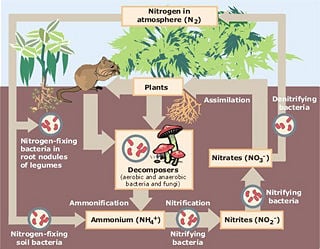The Nitrogen Cycle, Agricultural Science Basics
The following information about The Nitrogen Cycle, one of the Basics to understanding Agricultural Science, comes from The New World Encyclopedia which has generously provided access under a Creative Commons License. Reference information and access to the full article:
Nitrogen cycle. (2008, August 29). New World Encyclopedia. Retrieved 08:00, May 28, 2011 from https://www.newworldencyclopedia.org/entry/Nitrogen_cycle?oldid=794919.
If folks enjoy this type of post, please let me know by using the ‘Click to Comment’ button above.
The nitrogen cycle is the biogeochemical cycle that describes the transformations of nitrogen and nitrogen-containing compounds in nature.
The basic Earth‘s atmosphere is about 78 percent nitrogen, making it the largest pool of nitrogen. Nitrogen is essential for many biological processes; it is in all amino acids, is incorporated into proteins, and is present in the bases that make up nucleic acids, such as DNA and RNA. In plants, much of the nitrogen is used in chlorophyll molecules, which are essential for photosynthesis and further growth.
The nitrogen cycle reveals the harmonious coordination between different biotic and abiotic elements. Processing, or fixation, is necessary to convert gaseous nitrogen into forms usable by living organisms. Some fixation occurs in lightning strikes, but most fixation is done by free-living or symbiotic bacteria. These bacteria have the nitrogenase enzyme that combines gaseous nitrogen with hydrogen to produce ammonia, which is then further converted by the bacteria to make its own organic compounds. Some nitrogen-fixing bacteria, such as Rhizobium, live in the root nodules of legumes (such as peas or beans). Here they form a mutualistic relationship with the plant, producing ammonia in exchange for carbohydrates. Nutrient-poor soils can be planted with legumes to enrich them with nitrogen. A few other plants can form such symbioses.
Other plants get nitrogen from the soil by absorption at their roots in the form of either nitrate ions or ammonium ions. All nitrogen obtained by animals can be traced to the eating of plants at some stage of the food chain.




 Your Privacy Choices
Your Privacy Choices
I like it. Would love to see more soil-health related posts or other ag 101/201 stuff.
Thanks Brad,
Will do more of these for sure.
Largest problem, as for most any sales person,
is identifying VIABLE sales leads, and then easily tracking these leads through the sales process.
However it’s no surprise that some individuals get a bit bit intimidated by the
prospect of poking around in Excel.